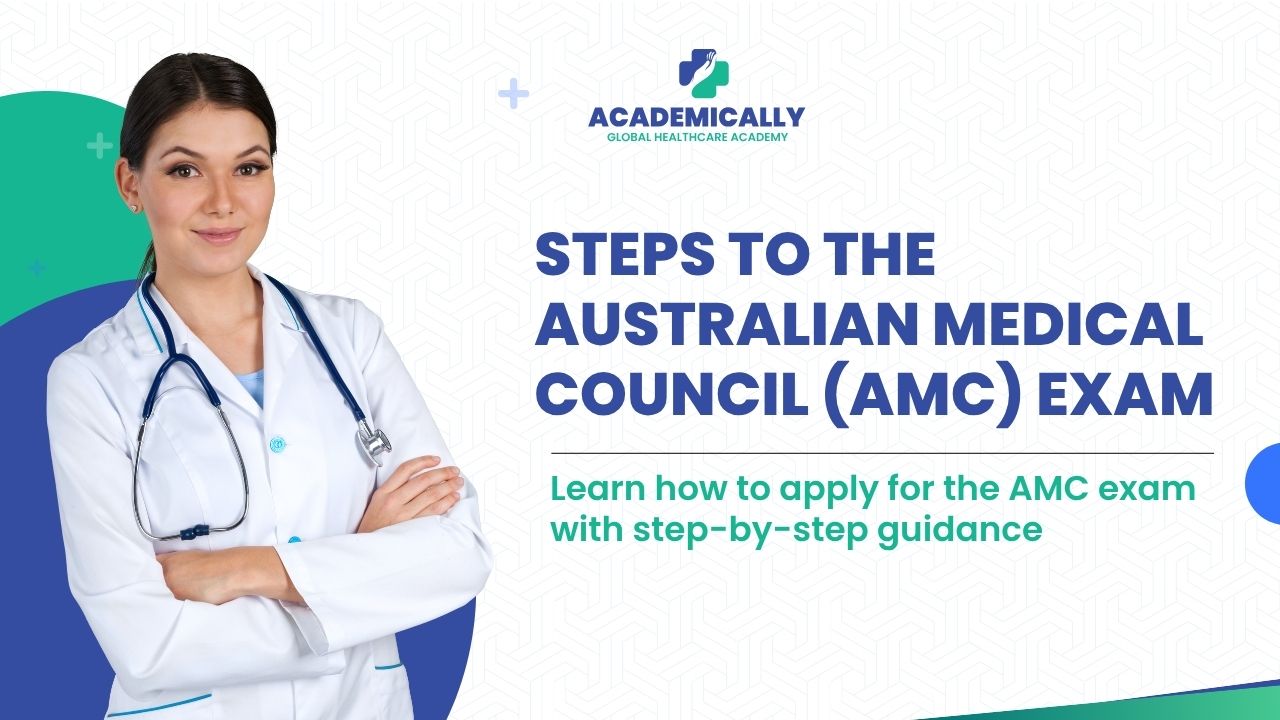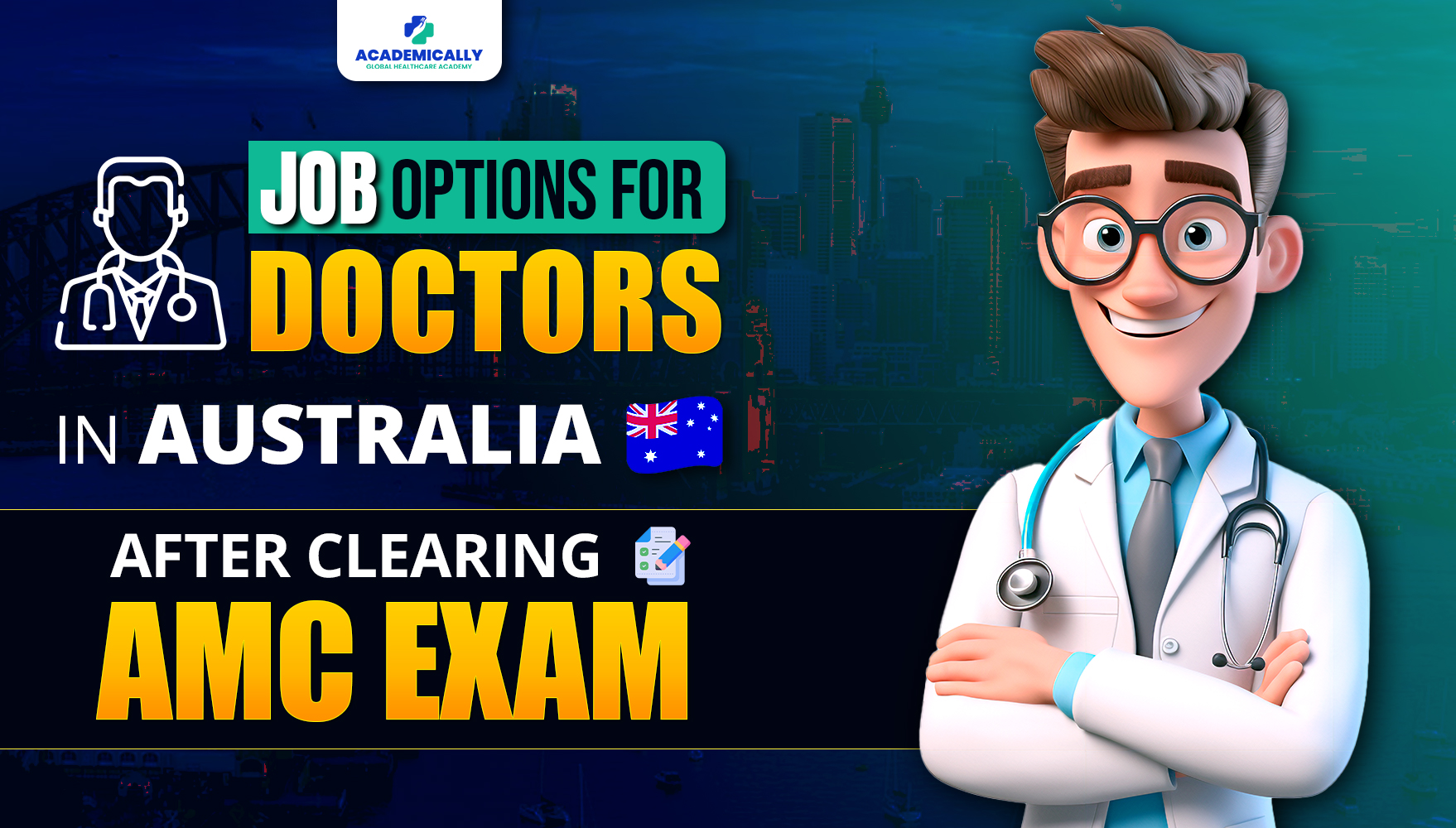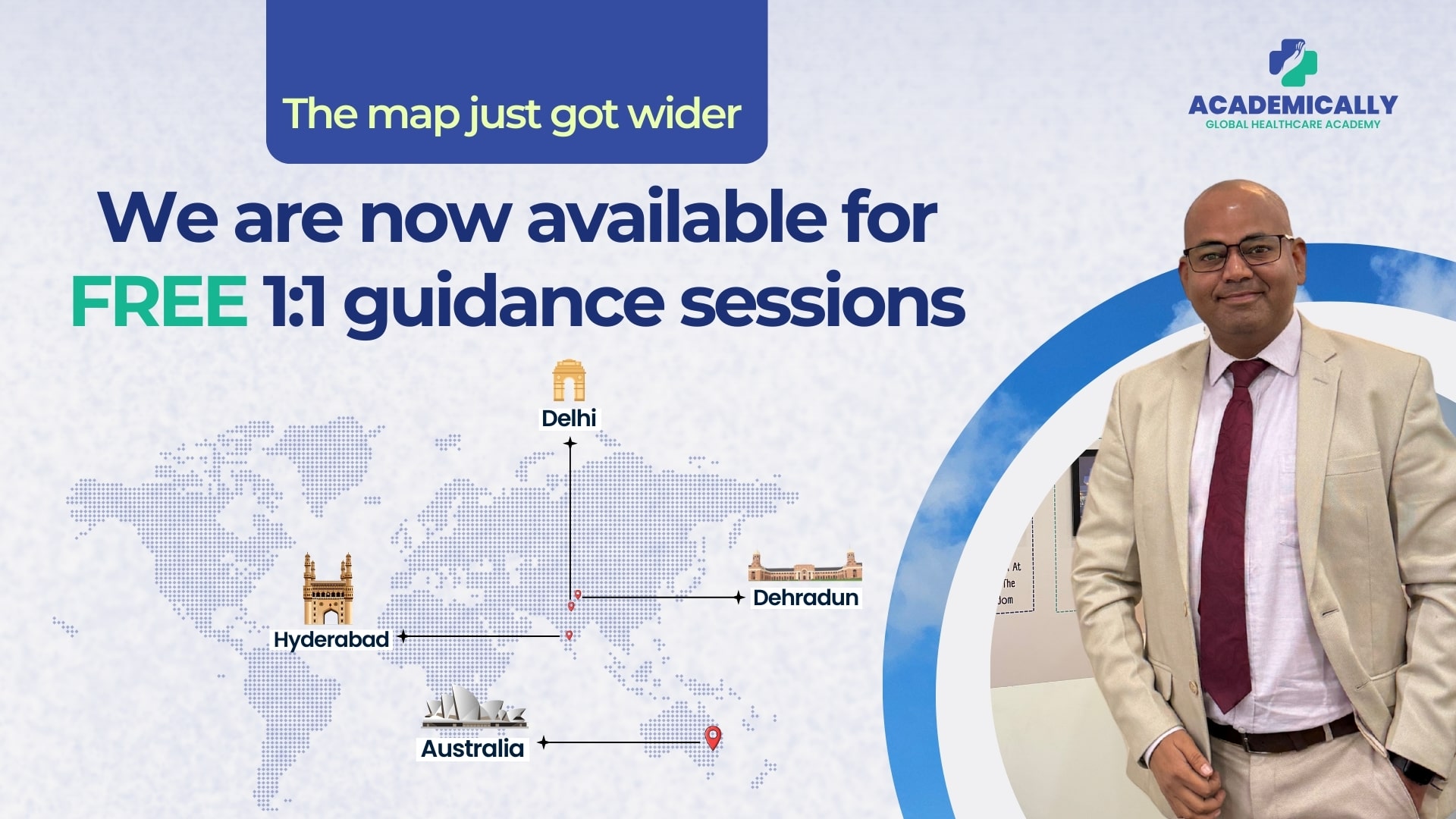Did you know… thousands of international medical graduates are choosing Australia as their overseas career destination by applying to AMC exam steps? The point is, most of the people aren’t much aware about the processes and it's completely okay. We are here to help you with the step by step process to complete your application for the AMC exam. Keep reading this blog post for more insights.
Understanding the AMC Exam
The Australian Medical Council (AMC) Exam is split into two distinct stages- commonly referred to as AMC Part 1 and AMC Part 2, with the latter also known as the Clinical Exam or OSCE.
What is AMC Part 1?
AMC Part 1 is a computer-delivered test composed entirely of multiple-choice questions (MCQs). It's often called the AMC CAT Exam (Computer Adaptive Test), and the best part? You don’t have to travel across the globe. This test can be taken online from the comfort of your own country, provided the conditions are met.
The exam is designed to assess your understanding of core clinical knowledge- the kind you’re typically taught during your final year of MBBS or MD studies. While its primary focus is on clinical scenarios, you might also encounter a few questions that touch upon foundational medical sciences. One thing to note is that there’s no negative marking, so you’re encouraged to attempt every question without the fear of losing marks for incorrect answers.
What Is AMC Part 2 (OSCE/Clinical Exam)?
Once you've successfully cleared the AMC Part 1 exam, the next big step on your journey is AMC Part 2, more commonly referred to as the OSCE. OSCE stands for Objective Structured Clinical Examination. This part of the assessment is where your clinical competence is truly put to the test.
Unlike Part 1, which is written and theory-based, Part 2 is entirely practical. It evaluates how well you apply your medical knowledge in real-life patient scenarios, just like you would in a hospital or clinic setting. Think of it as a simulated environment where you're assessed not just on what you know, but on how you think, respond, and communicate in real time.
With the right resources, strategies, and consistent practice through mock tests, especially using Rasch methodology or AI-based adaptive AMC mocks, you can successfully pass it on your first attempt.
The AMC MCQ exam uses Computer Adaptive Testing (CAT), meaning the test adjusts to your performance in real-time, simulating the actual exam environment.
Who can give the AMC Exam?
To begin with, you need to determine your eligibility and the most suitable registration pathway. You’re eligible to take the AMC exam if:
- You hold an MBBS, MD, MS, or equivalent medical degree.
- You have a degree certificate or course completion certificate.
- Your medical college is listed in the World Directory of Medical Schools (WDoMS).
Points to note:
- You do NOT need registration in your home country.
- You do NOT need to pass FMGE or complete an internship first.
What are the Available Pathways for the AMC Exam?
The AMC currently recognises four primary assessment pathways:
- Standard Pathway: For IMGs who haven’t completed an internship or specialist training in a recognised country and must pass both AMC exams.
- Competent Authority Pathway: For those who have completed medical education and internship in countries like the UK, Ireland, the USA, Canada, or New Zealand.
- Specialist Pathway: For experienced doctors who are already specialists in their home country.
- Short-Term Training Pathway: For IMGs seeking limited registration to undertake short-term training in Australia.
If you're interested in migrating to Australia as a doctor, it's important to understand the step-by-step process. There is an easy-to-follow 8-step process to become a doctor in Australia:
Step 1: Check Eligibility of Your Medical School and Degree
This first step is often overlooked, but it’s absolutely essential. You need to ensure your medical school is recognised by the AMC.
Here’s how to do it:
Step 2: Create a MyIntealth Account (For Primary Source Verification)
MyIntealth, operated by ECFMG, is the platform where you upload your medical credentials for Primary Source Verification (PSV).
To create your account:
All documents must be in English. If not, get them translated by an authorised service.
Step 3: Set Up Your AMC Candidate Account
Now that you have your MyIntealth ID, it's time to build your AMC profile.
Once your AMC account is verified, you can proceed to the portfolio setup stage.
Step 4: Build Your AMC Portfolio
This digital file will contain all your identity and qualification information.
Here’s what you need to upload:
- A clear photo (passport-sized, recent, colour)
- Copy of your passport
- Signature image
- Final medical diploma
- Postgraduate or specialist credentials (if applicable)
In case of any name changes or difference in documents, please provide only legally approved documents. Make sure every piece of information you input mirrors what’s listed on your official documents.
Step 5: Submit Documents for Verification
Now that your portfolio is set, your documents need to be officially verified.
Here’s how that works:
- Make sure you have nominated AMC as a recipient on MyIntealth.
- Wait for the "outsource notification" from ECFMG.
- Keep checking your AMC dashboard under “See qualifications” for status updates.
AMC will update your verification statuses to:
- Requested
- Outsourced
- Verified
Once everything reads "Verified," you’re ready to move forward.
Step 6: Choose which Pathway is the best for you
Let’s revisit the pathways briefly:
- Standard Pathway: Requires both the AMC MCQ and Clinical Examination.
- Competent Authority Pathway: For graduates from countries with recognised training, no AMC exams required.
- Specialist Pathway: For practising specialists outside Australia. You should contact the relevant Australian specialist college for assessment. Ensure you're at the right path before giving your exams.
Step 7: AMC MCQ Exam
The MCQ exam is the first exam to those who are going for the Standard Pathway.
Details:
- Format: Computer Adaptive Testing (CAT)
- Questions: 150
- Duration: 3.5 hours
- Venue: Pearson VUE test centres
- Cost: Approximately AUD 2720 (₹1.5 lakh)
Step 8: AMC Clinical Exam OR Workplace-Based Assessment (WBA)
Great news for IMGs! From 1 July 2025, the AMC has reduced the fees for both formats of the Clinical Exam:
- In-person Clinical Exam: From AUD 3,991 to AUD 3,000
- Online Clinical Exam: From AUD 4,391 to AUD 3,400
That’s almost AUD 1000 which is a big deal for IMGs who are already balancing relocation, living costs, and exam preparation expenses.
New AMC Clinical Exam Fees (Effective from 1 July 2025)
| Exam Format | Old Fee (AUD) | New Fee (AUD) | You Save (AUD) | New Fee in INR (Approx*) |
| In-person Clinical Exam | 3,991 | 3,000 | 991 | 1,68,104 |
| Online Clinical Exam | 4,391 | 3,400 | 991 | 1,90,518 |
Workplace-Based Assessment (WBA)
- Duration: 6-month programme
- Location: Conducted in accredited Australian hospitals
- Ideal for IMGs already working in Australia under supervised practice
Your choice depends on your situation and availability. WBA is often more practical for those already working in Australia.
Step 9: Receive Your AMC Certificate
Once you clear both exams (or the WBA) and your documents are verified, the AMC issues your Certificate. This allows you to apply for General Registration with the Medical Board of Australia.
Final steps:
- Download your AMC certificate from your AMC dashboard.
- Apply to AHPRA (Australian Health Practitioner Regulation Agency) for registration.
- Begin a successful medical career in Australia
Estimated Timeline
| Stage | Duration |
| MyIntealth & ECFMG Verification | 4-8 weeks |
| AMC Portfolio Setup | 1 week |
| MCQ Exam Preparation & Testing | 2-4 months |
| Clinical Exam or WBA | 3-6 months |
| Total | 6-12 months |
Estimated Cost Breakdown (2025)
| Item | Estimated Cost (AUD and ₹) |
| AMC Portfolio Setup | AUD 570 (₹32k) |
| MCQ Exam | AUD 2720 (₹1.5 lakh) |
| Clinical Exam | AUD 3000 (₹1.6 lakh) |
| Total | ~ AUD 6290 (₹3.5 lakh) + PSV & WBA (if applicable) |
Need help preparing for your AMC journey?
Pursue our comprehensive AMC exam preparation course by Academically. Here you’ll get expert led sessions, PDF handouts, AI based mock tests, community support and more. Have questions about the best PR pathways for AMC aspirants?
Our team of experts is here to guide you every step of the way.
Why Australia is the Top Choice for MBBS Doctors
If you're a medical doctor contemplating your next move internationally, one question likely crosses your mind: “Why should I choose Australia?” Especially when options like Canada, the USA, or Germany also seem promising. But let’s break it down with facts and a bit of real-world perspective.
Australia vs. Other Countries: A Clear Winner for Doctors
Canada may be appealing due to its streamlined permanent residency process. Germany, on the other hand, has ample job opportunities but requires fluency in German up to the B2 level — a steep challenge for many. The USA is competitive and often requires additional licensing exams, long years of residency, and no guaranteed job placement.
Australia, however, offers a unique mix of advantages that are hard to beat. It’s an English-speaking nation, making communication seamless for most international medical graduates (IMGs). The country has a well-structured, transparent medical licensing system, and its demand for doctors — especially in regional and rural areas — is only growing.
Unmatched Perks for Overseas Doctors in Australia
Doctors are highly regarded in Australia — not just as professionals but as essential contributors to society. In fact, medical professionals dominate the list of highest-paid occupations in the country. Neurosurgeons, for example, take home an average salary of AUD $600,000 annually.
Highlights
- You can earn an average salary between AUD $380,000 and $400,000+ per year.
- Work-life balance isn’t just a buzzword. Doctors typically work around 40 hours a week, leaving ample time for personal life.
- After gaining permanent residency (PR), you become eligible for Australian citizenship in just 3 years.
- Children receive free education up to Year 12, and the healthcare system (Medicare) covers your entire family once you hold PR.
- Spouses are granted full work rights, and your family can migrate with you without hassle.
- University-level education loans (HELP/HECS) are available for residents and citizens, making it easier for your children to pursue higher education.
- You can choose to work full-time, part-time, or even take up locum roles, which often pay even more for flexible hours.
- Australia grants over 180,000 PR visas every year, with healthcare professionals often prioritized.
- There are currently 10,000+ doctor vacancies across the country — especially in regional zones that offer added benefits for service.
Also Read:
- AMC Exam Eligibility Criteria
- AMC exam centres
- AMC Exam Preparation Books
- AMC Exam Syllabus
- AMC Exam Fees
Lifestyle That Respects Your Time and Sanity
In Australia, weekends are sacred. Most professionals, including doctors, take their personal time seriously. There's a cultural emphasis on family, outdoor living, and wellness. Crime rates are low, the environment is clean, infrastructure is modern, and public services are efficient.
Imagine this:
- You're earning over ₹3 crore a year (equivalent to around AUD $550,000).
- You're working reasonable hours; not burning out.
- Your kids go to school for free, your medical bills are covered, and your path to PR is laid out clearly.
- You enjoy beaches, national parks, multicultural cuisine, and safe, family-friendly communities.
It’s not a dream. It’s just Australia.
Thinking long-term? Australia checks all the boxes
Australia isn’t just a place to work. It’s a place to build a life. If you're an overseas-trained MBBS doctor wondering where to go next — Australia, especially in 2025–2026, is one of the smartest decisions you can make for your career, your family, and your future.
Looking for guidance on how to start your journey as a doctor in Australia?




